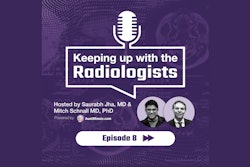AuntMinnie.com · Keeping Up With the Radiologists -- Episode 6: Katherine High, MD, gene therapy pioneer
Katherine High, MD, joins Saurabh (Harry) Jha, MD, and Mitchell Schnall, MD, for this episode of the "Keeping Up With the Radiologists" podcast series.
High persevered in bench-to-bedside studies of adenoassociated viral (AAV) vector gene therapies for hemophilia and blindness. A hematologist and molecular genetic scientist, she co-founded Spark Therapeutics, the Philadelphia-based gene therapy developer. These days, High serves as a board member for companies on similar journeys in breakthrough therapeutics and she's a visiting professor.
For those not familiar with Spark Therapeutics, Roche acquired the company in 2019 for $4.8 billion, but it's the backstory you'll hear in this podcast episode. High's conversation with Jha and Schnall will be of interest to radiologists and other healthcare professionals innovating in the academic medical setting, who are also feeling pulled toward moving (either a little bit or all the way) into a for-profit company -- one that could either complement or otherwise best align with their accomplishments.
From research and revenue in the academic mission to productive academic-industry partnerships and her company's initial public offering (IPO), eventually to the Roche acquisition, High has lived, worked, and managed at the center of it all.
"My work was moving forward quickly," High explained of a past collaboration with a biotech company. "They were producing the clinical grade [adeno-associated viral] AAV vector that we needed to move our hemophilia programs forward." Her work moved forward quickly as a result of the collaboration.
However, the really hard time hit. High shares the journey and the aftermath of the company's downfall following high-profile gene therapy adverse events -- "that didn't have anything to do with what we were doing but that caused a broad retrenchment in the field [of gene therapy development]," High said.
Beyond, she recalls her world of work, balancing talking to investors and participating in the general business news flow that biotech companies must navigate. Money became harder to raise. Large pharmaceutical companies started shying away.
Reaching perhaps one of the biggest obstacles of all, High presented her case to Steven Altschuler, MD, during his time as CEO of the Children's Hospital of Philadelphia (CHOP). Would he support clinical-grade vector manufacturing in the hospital? If not, High's work would grind to a halt.
"Fortunately for me [Altschuler] decided he was willing and found space for it," High shares during the podcast. What happened next?
Regulatory approval was possible. Eventually, the floodgates opened for investments in gene therapy. Start listening.
"I was very concerned about putting our technology into the hands of a company that was not exclusively focused on gene therapy," High explained. "I was worried that we would encounter a problem that we had not already solved and that the programs we were working on might be deemed too small to justify the increased expenditure to solve the problem."
Succeeding with a medical product will be affected by many factors, the conversation continues.
- Nurtured by a large academic medical center and valuation ...
- Support from venture capitalists and multiple rounds of funding ...
- Growing the product to a very mature state ...
"We had to progress it within the hospital because there was not really another path," High explained.
As you might expect, Jha draws a comparison to present-day AI. That's when Schnall really gets going in the episode, expanding on what comes next.
"Let's say you were to have a commercial entity come out of Penn Radiology, would you entice people to say you should try and build it within our system?" Jha asked. "And if so, what barriers do you foresee in it becoming commercialized and scaled?"
Risks and rewards: There are those who get to the point of creating commercial ventures that frankly have a big impact in the world, Schnall said. Yet many don't, as the conversation moves along ... matter of intellectual property, life cycle of biologics, spinning out companies.
"It's a little trickier in the computational world because things move fast, and it's hard to protect IP," Schnall continued, "and so mostly your value is your knowhow and your speed to market. Both those things, universities really struggle with trying to figure out how to spin off. They're starting to get better at it ... it's rare that I've been to a department where somebody doesn't have an AI company, if not multiple faculty there have an AI company. I think we're starting to see a lot of it."
An innovator will face difficult decisions.
- Transitioning from the protective environment of the university to a company ...
- Bringing people in who have lots of experience in one area but have never done what you're doing ...
- The best chance that programs have to make it -- when you have been the long-standing face ...
"I had some trepidation," High revealed, with more on what came next and Schnall's perspective.
"It strikes me that many still make this false dichotomy between being in academia, being in industry, or starting a company," Jha continued. "People are seeing successes and there are many models."
"The complete spinoff model is not the most common but becoming more prevalent," Schnall said.
The path forward may not be spelled out. Whether you are contemplating making your move from academia or watching from the sidelines with interest and perhaps a project of your own, this is an episode you don't want to miss. Listen now.
More impressions from this episode:
{01:18:14} About Katherine High, MD
{02:30:21} Moving forward quickly
{05:37:22} Diversifying focus
{10:35:13} The CHOP effect
{11:41:21} Valuation
{14:21:03} AI
{15:41:17} Barriers to commercialization
{17:35:16} Academic innovators
{19:03:24} Spinning off an enterprise
{26:55:08} Taking off from academic
{32:33:16} Regulators and multiple paths to market
{33:22:16} Using products off-label
{35:23:21} Raising money
{37:31:20} Going public
{38:22:07} Where to locate for biotech
{50:01:00} Speed to market
Special guest:
Katherine (Kathy) High, MD, is an accomplished hematologist and, previously, a long-time member of the faculty at the University of Pennsylvania and the medical staff at Children's Hospital of Philadelphia (CHOP). Once president and co-founder of Spark Therapeutics, she is now a visiting professor and board member for other companies. High is a physician-scientist and pioneer in studies of gene therapy. She is also a past president of the American Society of Cell and Gene Therapy and served a five-year term on the U.S. Food and Drug Administration's Advisory Committee on Cell, Tissue and Gene Therapies.
Hosts:
Saurabh (Harry) Jha, MD, MBBS, is an associate professor of radiology at the Hospital of the University of Pennsylvania. Jha obtained a master’s degree in health policy research from the Leonard Davis Institute at the University of Pennsylvania. He earned his medical degree from the United Medical and Dental Schools of Guy’s, King’s, and St. Thomas’ Hospitals. Jha developed Value of Imaging, a set of radiology educational resources.
Mitchell Schnall, MD, PhD, is a physician at Penn Medicine in its abdominal imaging services program. Chair of the department of radiology and the Eugene P. Pendergrass Professor of Radiology at the Perelman School of Medicine, Schnall has served as the group co-chair of the ECOG-ACRIN Cancer Research Group since its founding in 2012. He is an international leader in translational biomedical and imaging research, working throughout his career across the interface between basic imaging science and clinical medicine to ensure effective integration of radiology research with other medical disciplines.
This episode of Keeping Up With the Radiologists is brought to you by AuntMinnie.com in collaboration with Penn Radiology. The series is also available on Spotify and Apple Podcasts. Check back for new episodes!




















